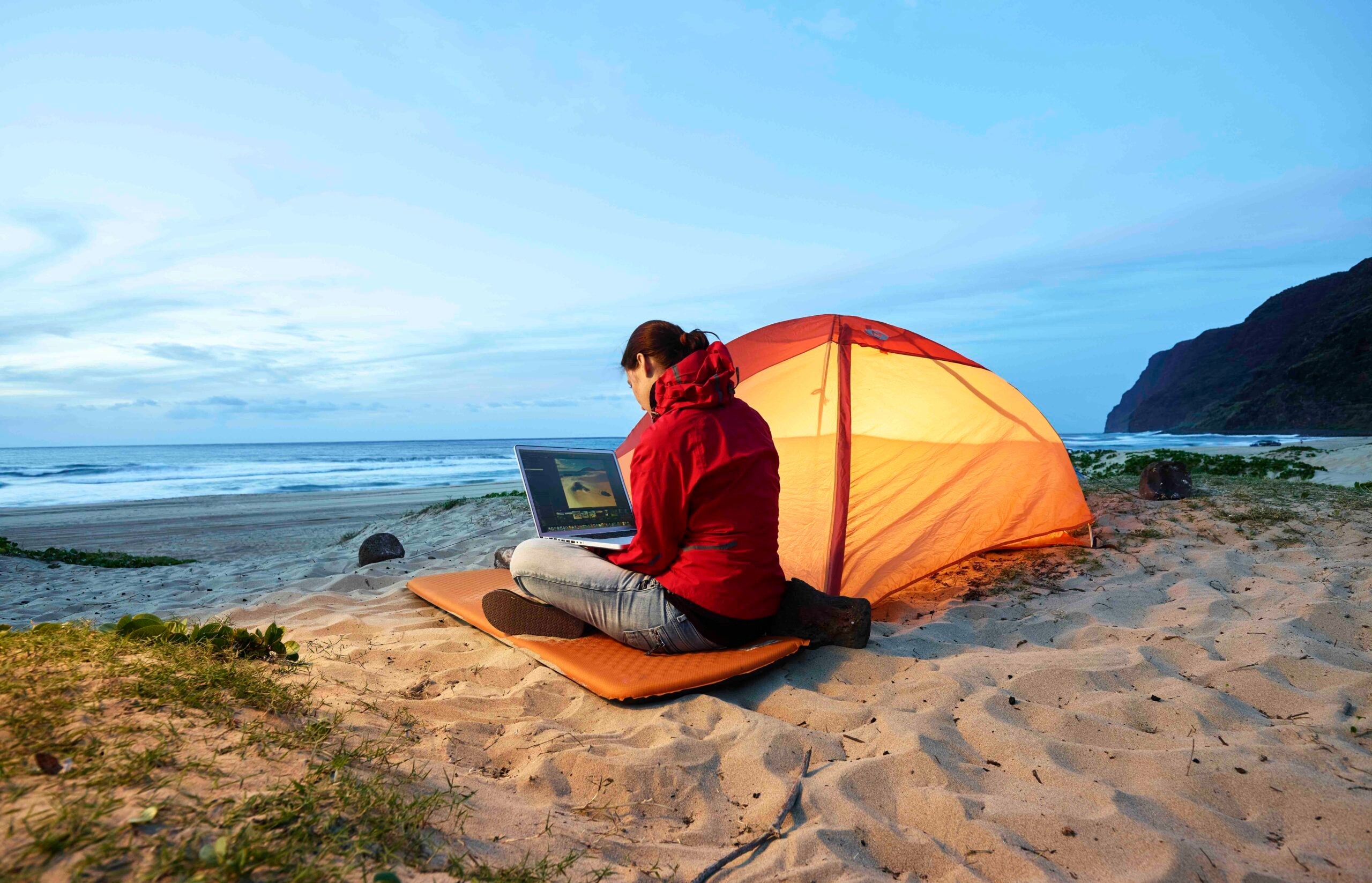The world of outdoor business sure feels a long way from Silicon Valley. But make no mistake: technology has become the backbone of the industry, guiding everything from the way we run our businesses and communicate with each other to how we design new gear and battle climate change.
Here, we’ve collected and examined dozens of ways tech is transforming the outdoor industry to get a glimpse of how these advancements might shape the future of our work and play in the outdoors.
Tech is…Connecting Us
By Heather Balogh Rochfort
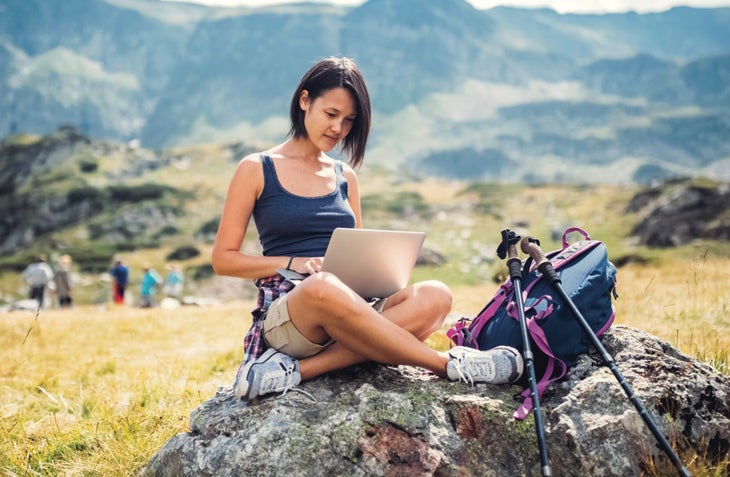
The Rise of Digital Memberships
When I co-founded WildKind, a virtual community to help parents get outside with their kids, a digital component wasn’t on my radar. My partner and I just wanted to provide guidance for families hoping to tackle outdoor adventures. We envisioned baby backpacking trips and mom-only bikepacking excursions—not laptops and virtual community forums. But we dug into the data, and the numbers didn’t lie: digital subscriptions are booming.
We realized the power of the internet was twofold: it reached more families than we ever could with in-person-only instruction, and it allowed time-starved parents to consume the information in the small respites between bath time and lights out. This was confirmed when we launched in August 2020 and acquired 300 new members within two weeks, all eager to pay $99 per year to capitalize on virtual skiing and camping courses, members-only discounts from various outdoor brands, a digital forum, and discussion panels.
For their part, partner brands like Merrell and The North Face were excited to collaborate, since it gives them name recognition with an audience willing to spend a little money to get outside.
We’re not the only business to make the leap into digital memberships over the past year. Run to the Finish founder Amanda Brooks launched the Online Running Club in June 2020: more than 500 members pay $18 per month to gain virtual access to running coaches, workout programs, drills, and community. “It’s an easy way to bring people together and help them get the support they need,” Brooks said.
She also noted that membership is a successful entry point into her brand, which also sells products like books, T-shirts, and individual coaching. “They join at this affordable monthly rate, get to know me, and start asking what else is available. It’s enhanced the connection with my community, making them true fans.”
And in outdoor media, ���ϳԹ��� (���ϳԹ��� Business Journal’s parent company) launched its ���ϳԹ���+ membership earlier this year, which features perks like exclusive content across its publications, online education courses, a personalized feed, and access to Gaia GPS for navigation, all for $99 per year.
According to Gartner, a global IT research and advisory firm, digital memberships are a top trend, particularly subscription services: the firm predicts that by 2023, nearly 75 percent of direct-to-consumer businesses will offer one. Outdoor brands largely haven’t jumped on board yet, but Ralph Lauren provides an example of what this might look like: its membership (starting at $125 per month), which launched last year, allows users to select items for a “dream wardrobe” subscription box that includes four items for rent or purchase.
Are You in the Club(house)?
Launched in March 2020, Clubhouse is the latest in social media apps designed to emphasize real-time conversation via live audio content—no images, no curated feed, and no website. Users can pop into live chat rooms to listen to a variety of discussions as well as request to participate in the conversation.
According to Arial Macrae, marketing manager of Roam Media Inc., an adventure club that produces videos and mini-documentaries and boasts founding members like Jimmy Chin and Sasha DiGiulian, this is the crux of the platform: “It opens the doors and gives fans access to your brand’s conversations and gives people the opportunity to speak up and be a part of it,” she said. During the winter months, Roam hosted a weekly chat room highlighting a number of outdoor industry topics, from photography with Chris Burkhard to a series of panelists sharing their outdoor career stories.
Since Clubhouse is all live content, the commitment is minimal. “Pro endurance biker Rebecca Rusch joined a room while she was actively on a training ride,” Macrae laughed. Unlike a podcast, Clubhouse allows brand consumers to actually participate with the people behind the logo and ask them real-time questions. In short, the interaction puts a friendly voice to the brand name.
While initially only available on iPhone, this invite-only app recently opened to Android users in May 2021, garnering a million new sign-ups within two weeks. It’s still relatively small with ten million total users, but it’s growing quickly. Thought leaders and brands who welcome one-on-one conversations with consumers are most likely to benefit from the app, so experts suggest that people in leadership create their own accounts rather than hosting from their business name. “There’s a lot of potential there,” Macrae said. “This type of direct access to a brand gives a personal touch you can’t find on other platforms.”
The Insta-Success Formula
According to Kami York-Feirn, marketing manager for apparel brand Wild Rye, there are three core tenants to a successful business Instagram account: a consistent posting schedule, a relatable caption with a strong call to action (like an audience question), and video/reels content to appease the Instagram algorithms.
York-Feirn looked at some of the most popular posts so far this year from three industry accounts to help us understand what other factors can get people liking, sharing, and commenting.
Wild Rye’s formula for success: Fun hashtags + relatable caption + Monday post (one of the brand’s best days for engagement)
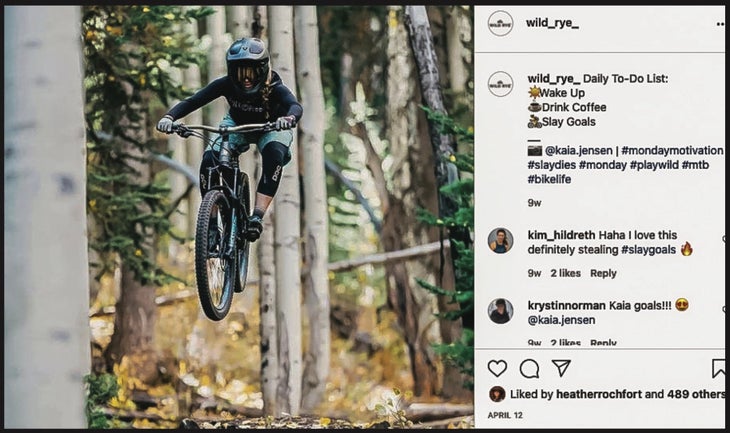
Patagonia’s formula for success: Environmental topic + short video + controversy
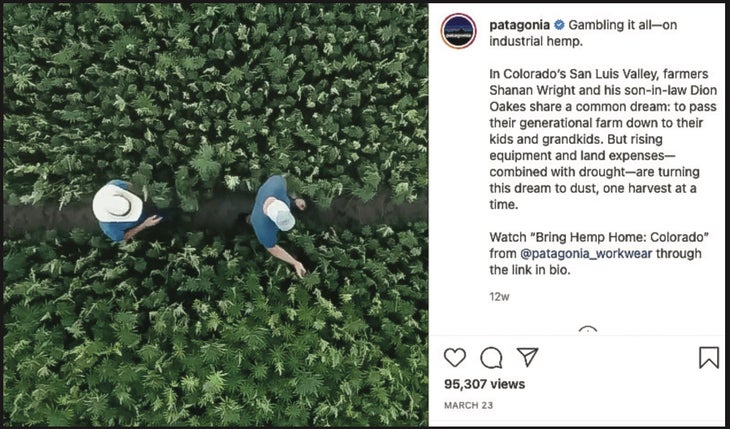
Unlikely Hikers’ formula for success: Relatable story + request for shares in the caption + relatable photo to encourage conversation and boost visibility with the algorithm
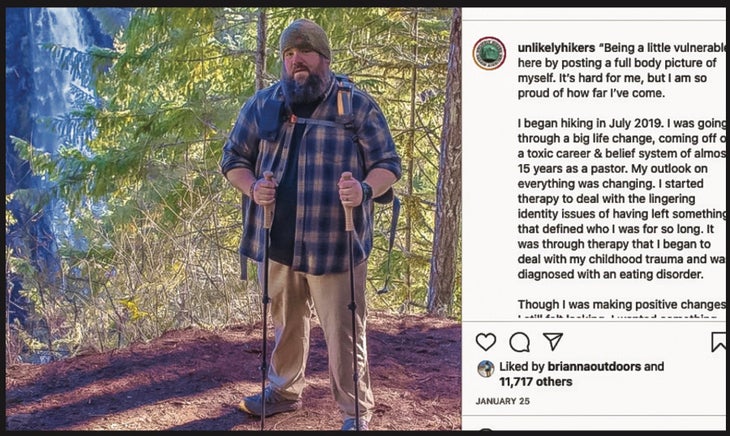
Slack Better
You know Slack. You love (okay, or maybe hate) Slack. But are you Slacking to your fullest potential? These three integrations take your work collaboration to the next level.
Donut: Get to know each other through virtual introductions, auto-scheduled “coffee dates” between team members, and even a CEO lottery that randomly selects one person for a chat with the boss.
EventBot Calendar: Never forget a team birthday or meeting with this all-inclusive calendar that hosts your entire team’s events from within Slack.
HeyTaco: Give your coworkers a nod for a job well done via the only virtual currency that matters: tacos. Everyone gets five virtual tacos to award per day, and the app tracks a team leaderboard for extra motivation.
Tech is…Saving the Planet
By Tracy Ross
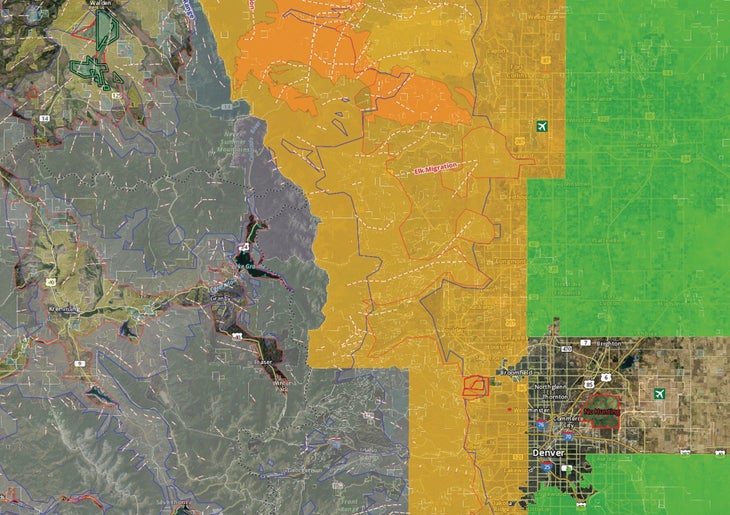
Unlocking Public Lands
In January, President Biden announced his “30 x 30” vision to conserve at least 30 percent of U.S. lands and freshwater and 30 percent of U.S. ocean areas by 2030. One priority: boost outdoor recreation by encouraging the voluntary conservation of private land through which bordering public lands can be accessed. That offers the opportunity not only to protect a larger area of contiguous wildlife habitat, but also to open the door to public lands that may be difficult or impossible to reach.
The mapping app onX, which launched to give hunters a simple way to see whose land they were on, has been collecting data on these public-private intersections for more than a decade. So far, the team has identified some 16.4 million acres in 22 states that are currently inaccessible to the public because of surrounding private land. This info funnels into the hands of local, state, and federal land managers, who are using it to identify possible easements with the end goal of creating more access to public lands for all.
Building Urban Parks
The Trust For Public Lands (TPL) knows we have a critical green-space equity problem in our country, with studies showing that some 100 million of us—including 28 million kids—lack access to local parks within walking distance. So TPL used 20 years’ worth of data to create ParkServe.org, an interactive map that shows exactly where green space is most needed in American cities. TPL also helps cities look for funding for park construction. And one of the best benefits, says Lisa Hwang, TPL’s managing director of strategy and innovation, is that anyone can join in the process of designing or creating a new neighborhood park.
Navigating Climate Change
Heat waves, wildfires, floods: we’re already living with the effects of a changing climate. Last year, Gaia GPS (owned by ���ϳԹ��� Business Journal’s parent company) introduced several free map layers that aim to help people deal with fire-related issues. Two wildfire maps give precise, real-time info about where fires are currently burning, based on NASA satellite heat detection data that’s fact-checked with firefighters on the ground.
Two more maps depict current and predicted air quality based on info from the Environmental Protection Agency’s AirNow program, which draws from several monitoring organizations to show where pollutants in the air pose a health hazard.
Sharing the Immigration Story
“Storytelling has always been a powerful tool for social movements, and conservation is no different,” said Christian La Mont, program and communications manager for Latino Outdoors. This past March, the nonprofit partnered with The National Audubon Society for a yearlong project called Mapping Migraciones. It weaves the Latino community’s migration and immigration stories together with the migratory paths of birds, combining the two into an interactive map that ties humans and nature together into an ongoing narrative.
Click on a bird—say, a Swainson’s Thrush— and see its migratory path from Central America to as far north as Canada. Then click on the name of a person, and see how he made his journey along the same route. “The interactive map shows that migration is not only nuanced and natural, but also beautiful,” said La Mont.
Lifelines for Firefighters
Wildland firefighters have one of the most dangerous jobs in the outdoors. But new developments are making their task a little safer—as evidenced by the tech used by a Montrose, Colorado, Helitack crew while fighting the 2018 Tabeguache Fire in the Uncompahgre National Forest.
Lack of connectivity and limited sight lines in steep canyons makes firefighting in the area extremely dangerous. But each crew member wore a 2.8-ounce goTenna Pro X tracking device, which shares location info among teams of firefighters via a broadcasting process called meshing.
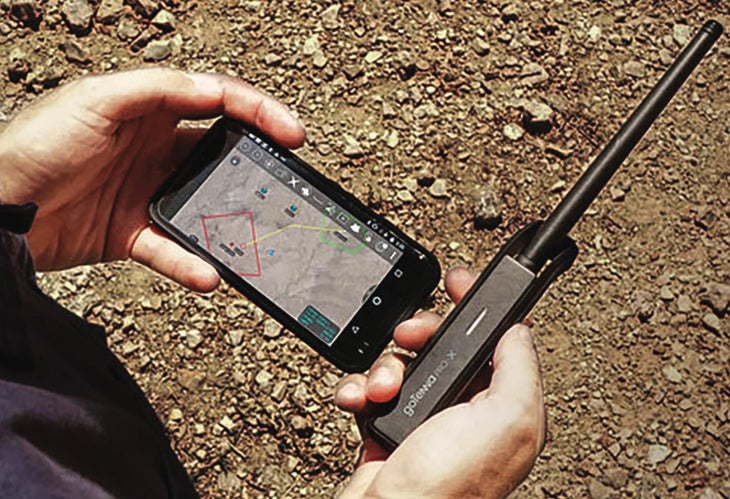
Tracking devices pair to any phone using an app like ATAK. Firefighters can then use their phones to navigate to safety, tell tankers where to drop retardant, and report back to management teams.
Fire Incident management teams can then pair location info with the data service Cornea to get real-time maps showing the location of crew members, retardant drops, and the most dangerous parts of a fire. Cornea also collects and fuses data about fuels, weather, topography, watersheds, and the probability of fire spread from multiple sources.
The Upside of Drones
Drones get a bad rap for invading privacy and harassing wildlife, but that’s only half the story. The National Audubon Society said drones “don’t just offer a safer way for scientists to observe their subjects; they’re often less costly, more efficient, and more precise than traditional approaches.” Here are six ways the organization Conservation Drones, which built a low-cost flier (starting at $3,500) specifically for conservationists and scientists, is using these aerial machines for good.
- Surveying heron populations under thick forest canopies in England
- Flying aerial surveys along tidal creeks in the Bahamas to count sharks, rays, and sea turtles—all creatures that are both threatened and difficult to monitor
- Studying whales’ health with “snot bot” drones equipped with petri dishes that hover at the whale’s blowhole to collect a sample of its breath, which includes discharge containing lung bacteria, viruses, and DNA
- Monitoring the spread of invasive aquatic plants at Lake Carl Blackwell in Stillwater, Oklahoma
- When equipped with thermal-imaging cameras on their undersides, identifying species like orangutans in Borneo, spider monkeys in Mexico, and riverine rabbits in South America to show health and range of populations
- Using thermal cameras to detect and monitor “peat megafires,” which destroy essential peat land ecosystems and are responsible for 15 percent of annual global greenhouse gas emissions
Tech is…Designing Gear
By Frederick Reimers
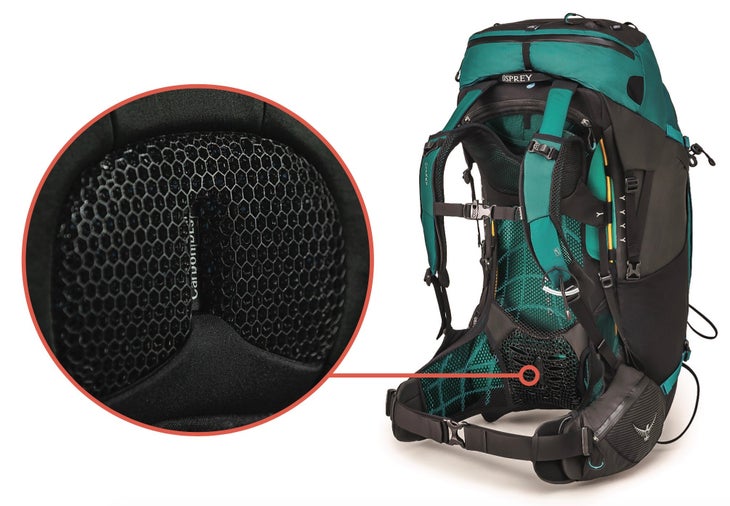
The Power of Three Dimensions
Silicon Valley 3D-printing firm Carbon has recently made inroads into the outdoor space with shoe soles for adidas and bike saddles for Specialized. Both feature latticework made from elastomeric polyurethane (EPU), which is remarkably elastic (capable of being elongated 250 percent before it breaks) and, in lattice form, great at returning energy. More importantly, Carbon can tune the latticework’s compressibility by location within the design, which can help accommodate the variances of, say, foot shape, or enable targeted cushioning.
And this fall, Osprey is using the tech to make a giant step forward in pack design. Along with a host of other new technologies, the UNLTD Antigravity 64 and Airscape 68 feature lumbar pads built by Carbon: the company’s tunable 3D printing allowed Osprey to make them more compressible on the top and front to create consistent and extremely comfortable contact with a wide variety of lower-back shapes. The latticework is also exceptionally breathable, grippy, and springy, so even under very heavy loads, the pack feels more secure and balanced.
The 3D-printing process was also a designer’s dream. With remarkable speed, it creates shapes impossible to make with injection molding. In just over a year, Carbon was able to iterate close to 100 different permutations of the design, all with far less waste than injection molding. Working with the emerging technology isn’t cheap—the packs ring in at an eye-watering $700—but Osprey owner Mike Photenhauer said he wanted to showcase what’s possible in pack design “when price is no object.”
Saving the World, One Shirt at a Time
A pair of Stanford professors founded the startup LifeLabs this year to create fabrics that combat climate change. According to the Department of Energy, if Americans would simply raise their thermostats 2°C higher in summer and 2°C lower in winter, it would save an average of 6,000 pounds of atmospheric carbon per household (about a 20 percent reduction in a home’s total energy use). Better temperature-regulating clothing could make that easier.
Enter the company’s CoolLife fabrics, which are made from polyolefin (think kitchen cling wrap). The material allows 100 percent transmission of infrared radiation—the only known fabric to do so—letting body heat escape faster. LifeLabs invented the process of creating knit and woven fabrics from polyolefin: the trick, said LifeLabs CEO Scott Mellin, was to build yarn extrusion and knitting and weaving machines that could handle the material’s low melting temperature (122°C versus nylon’s 220°C).
The company’s WarmLife fabrics use a different strategy, employing reflectivity to capture body heat. The concept isn’t new, but the WarmLife fabric is breathable enough for the reflective metallic nanocoating to cover 100 percent of its surface (in comparison, Columbia’s Omni-Heat reflective dots cover just a third of their items to maintain breathability). The result is a garment that requires 30 percent less insulation for the same CLO value. The tech hasn’t hit the market yet, but this summer LifeLabs is releasing 16 garments (insulating parkas and gloves, cooling leggings, and sleepwear) to investors, media, and influencers.
Artificial Intelligence Revolutionizes Bike Design
Imagine bike frames that look like they’ve been built by a spider, with hollow, sinewy strands linking the handlebars, wheels, and bottom bracket. The frames are lighter for subtracting material, but according to the engineering software that created it, just as strong.
That’s the concept behind French gear titan Decathlon’s bike design project with software firm Autodesk, which has also partnered with component maker SRAM. The idea is that Autodesk’s Fusion 360 software can take inputs like weight, dimensions, and strength and then generate hundreds of potential designs in just a few hours, all theoretically capable of standing up to the demands of the design problem, even if they may be unusual in appearance.
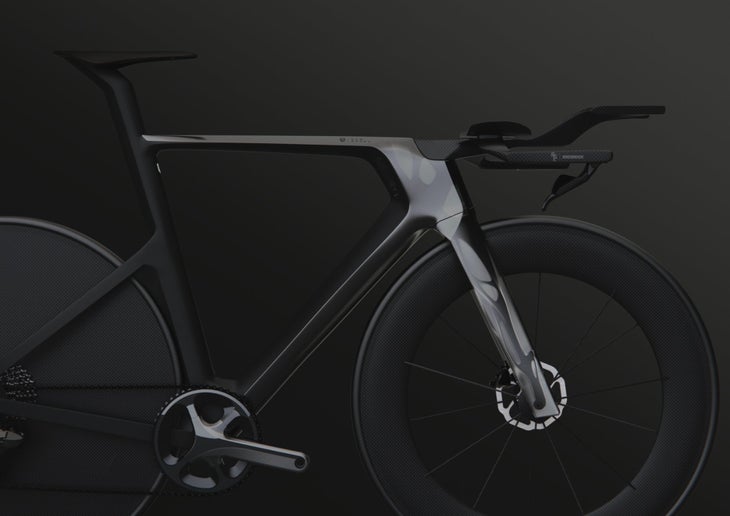
The software can also learn as it goes, basing subsequent rounds of design on those preferred by the human engineers. Such designs are particularly suited for the elaborate shapes possible with 3D printing. For SRAM, it means printing a latticed aluminum crank arm that’s just as light and strong as a carbon fiber one, at a lower financial and ecological cost. SRAM is currently testing a few of those designs in the field, and the process bodes well not just for bikes, but also for climbing gear or any equipment that prizes light weight along with strength. Just as intriguing is another goal of Decathlon’s so-called “vision project” with Autodesk: to explore the process of custom-printing bikes according to a customer’s individual preferences and dimensions.
Upgrading Portable Power
Solar, not wind, has dominated the portable power scene because solar panels are so much smaller and lighter—until now. Enter the Shine Turbine. A marvel of efficient design, the device boasts an exceptional weight-to-power ratio compared to other portable renewable devices. The three-pound device, which launches this summer, is capable of generating 40 watts, good enough to charge a smartphone in as little as 15 minutes, and trumps water turbines, thermoelectric stoves, and even solar panels with a 13 watts-per-pound ratio. The Shine Turbine folds into a sleek package about the size of a liter water bottle and deploys in minutes. Designers solved challenges like dissipating the motor’s heat and capturing high power outputs while meeting size restrictions, but the Shine Turbine’s real triumph is in the blade design: they’re efficient enough to withstand 28-mph winds (minimum speed: 8 mph) while still folding snugly into the body.
Can Algae Replace Chemicals?
Quick, name a product you use that doesn’t include petroleum-based plastics and chemicals. Tough, right? But here’s some good news for reducing our petroleum dependence: design firm Checkerspot aims to solve the problem, starting with the outdoor industry. Growing out of work done at the University of California, Berkeley, Checkerspot develops oils derived from fermented microalgae. The company is currently working with Gore to create petroleum-free DWR, and a project with Swiss chemical firm Beyond Surface technologies has resulted in a microalgae-based wicking treatment that hits the market this year in garments by streetwear brand Pangea.
Checkerspot also supplies algae-based polyurethane for its own ski brand, Wndr Alpine. And there’s more on the horizon: the ski maker plans to develop its own line of greener packs and apparel incorporating the Beyond Surface coatings and algal polyurethanes for hard pieces like pack buckles.
Wearables Get Even Smarter
The future of fitness wearables looks increasingly detailed—and some might say, invasive. Swiss company Core’s body temperature monitor has been used as a training tool by pro cycling teams for a few seasons, but it’s now available to the public. The device clips onto an elastic chest strap and sends continuous body temp readings to a smart device. Excess body heat saps an athlete’s power output, so such monitoring can help athletes strategize during competition, telling them whether to drop the hammer or back off until they’re cooler.
Also launched this spring: a partnership between Garmin and blood-testing company Inside Tracker that combines smartwatch data like blood oxygen and stress levels with the genetic biomarkers the company derives from periodic lab-administered blood tests. The result is customized training and nutritional advice—like increasing your sleep or upping magnesium levels—to optimize performance.
Even more frequent exposure to needles is required for an upcoming glucose-monitoring system from Supersapiens. Based on existing technology made for diabetics, a needle pressed under the skin and adhered to the tricep is synced with a smartwatch or phone for live monitoring to help athletes stay optimally fueled.
Tech is…Running Our Businesses
By Cindy Hirschfeld and Elisabeth Kwak-Hefferan, with reporting by Tatiana Walker-Morris
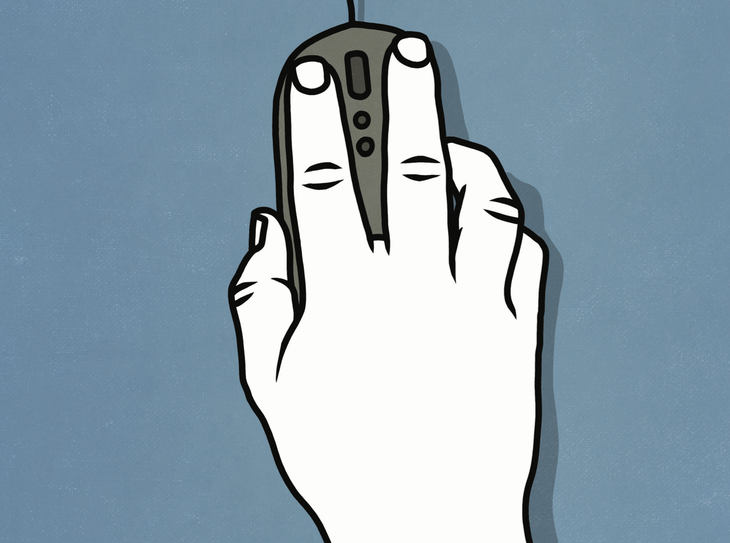
Personal Shopping Service
When Mike Peters decided to buy an e-bike earlier this summer, online retailer Curated connected the Denver shopper with an e-bike expert in Illinois, and the two texted for a few days. Peters liked the convenience of shopping on his own time, and that his expert felt brand agnostic—“You could ask about any bike, not just the stuff they had in a store”—so he placed an order.
The shopping experience at Curated, which launched in 2017 and sells gear for hiking, skiing, cycling, fly-fishing, and more, starts with a series of questions about experience level and gear preferences. Then the company’s artificial intelligence program matches the customer with an actual person to help them find the best product. “I don’t think people would ever want to buy a $2,000 pair of skis from a chatbot,” said founder Eduardo Vivas. Though Curated has about 100 brand partners, the company will source any item a customer and expert choose.
Vivas said his business isn’t about steamrolling brick and mortar. Outdoor Gear Exchange (OGE) in Burlington, Vermont, is one of 25 or so retail partners that sell gear through the platform, lopping off a commission for Curated (OGE sends them 10 to 15 percent). “It’s a little bit more than other affiliates that we work with, but [Curated] drives more in sales,” said Ivan Tighe, director of fulfillment and communications—the platform drove 630 orders last January alone.
And on the brand side, Curated offers anonymized customer data to its partners quarterly, which clues vendors in to how they’re performing with different demographics or regions and shows them how often buyers pick their gear from the expert’s list of recommendations.
Affiliate Gear Sales
We’ve all seen those dubious “best of” lists, compiled solely to get cash for clicks. But when established digital outlets pursue the affiliate sales game, do they risk eroding reader trust? Not necessarily. Media brands say they’re able to earn money from recommending products while maintaining editorial integrity.
For larger online pubs, that means having separate affiliate sales teams to deal with logistics while letting editors have the final say over what gets covered. At Lola Digital Media—owner of Gear Junkie, Switchback Travel, and other sites—“the editorial and affiliate linking are totally separate,” said VP of commerce David Wilkinson. In 2020, the company produced $200 million in sales for retail partners and direct-to-consumer brands (Wilkinson declined to say what the partnership netted for Lola).
At Gear Patrol, where affiliate sales comprise about 20 percent of revenue, head of commerce Brian Louie said the editorial mission comes before the links: “Readers can tell if something is forced.” The same holds true at ���ϳԹ��� (a sister publication to ���ϳԹ��� Business Journal). “We work to optimize the content that we are already creating for revenue,” said Katie Cruickshank, senior digital marketing manager. “And we’re not going to cover anything editorially just because there’s a good commission rate.” Sales bring in some 10 percent of overall digital revenue.
Meanwhile, the increased sales channels and ability to track conversions warrant the revenue sharing for brands and retailers. “I think it’s the most powerful type of marketing on the internet today,” said Wilkinson.
6 Workflow Apps We Love
You’ve been hitting Zoom, Microsoft Teams, and all the Googles hard for the past year or so—but they’re far from the only programs that make your work life easier. Have you met these standouts?
- Trello. Collaborate with colleagues on to-do lists, set deadlines, and track shared projects. Free (basic); $10/person/month and up (advanced).
- Canva. Design as a team with templates for everything from Instagram posts to logos. Free (basic); $10/person/month and up (advanced).
- Otter Voice. Take meeting notes quickly with this live transcription app for computers and phones. Free (basic); $8.33/person/month and up (advanced).
- Calendly. Schedule meetings by syncing your calendars and letting people choose from your available times. Free (basic); $8/person/month and up (advanced).
- Mural. Play around with workflow diagrams, graphs, and even freehand sketching for remote teams. $12/person/month and up.
- Harvest. Find out how much time you’re spending on specific projects with this time tracker app. Free (basic); $12/person/month (advanced).
The Biggest Gear Breakthroughs of All Time
By Amelia Arvesen
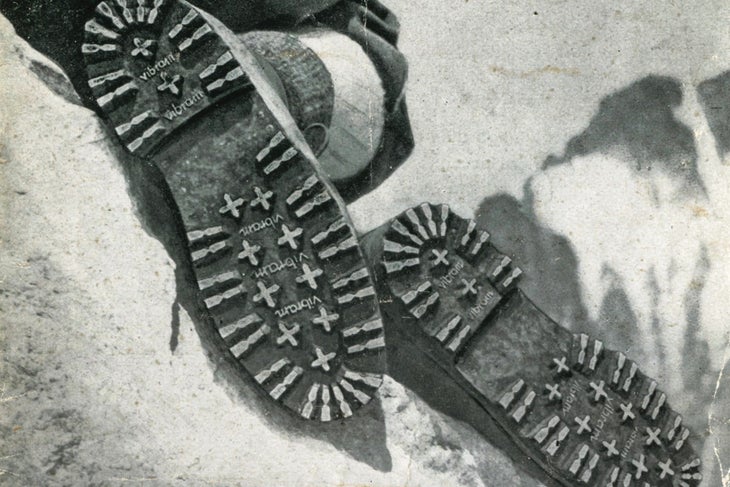
These ten innovations revolutionized the business of outdoor, according to gear historians and longtime industry members.
1927: Pin bindings.The groundbreaker here was the Rottefella six-pin binding. Before pin bindings, skiers used wicker and leather toe straps to tie wooden planks to their feet. Norwegian engineer Bror With’s clamp-and-spike invention keeps skis more secure and makes walking less cumbersome.
1937: Vulcanized rubber outsoles. This groundbreaker was the Vibram Carramato sole. Vitale Bramani was inspired to make leather boots better after friends died while mountaineering in 1935 in the Italian Alps, in part due to footwear that froze. Bramani beefed up the soles by incorporating a tread design traditionally used for automobile tires.
1968: Avalanche transceivers. Scadi was the first product in this new category. Avalanche experts were experimenting with different electromagnetic methods of locating buried people from above the snow when researcher John Lawton at New York’s Cornell Aeronautical Laboratory created a handheld device with the longest range and best accuracy yet.
1969: Internal-frame backpack. The Lowe internal frame pack was the first. In a basement in Colorado, Greg Lowe made the first pack that integrated the supportive structure into the back panel. It was first made of phenolic resin layers and later revised to aluminum frame bars. Hips and shoulders everywhere rejoiced.
1977: Expanded polytetrafluorethylene (ePTFE) material. Gore-Tex was the pioneer in this category. While tinkering with the polymer, Bob Gore discovered it could stretch by up to 1,000 percent and transform into a new substance with tiny pores that allow air to pass through. His invention, later called Gore-Tex, is now a household name.
1977: Sports bra. Credit the Jogbra as the first. Ditching the impractical underwire of the past, Lisa Lindahl, Hinda Miller, and Polly Smith sewed together two jockstraps to make a more supportive and comfortable bra that they could wear while running and playing sports. Sports bras have come a long way since then.
1978: Spring-loaded camming device. “The Friend” was the groundbreaker. After Ray Jardine invented the first modern trigger-activated pieces of climbing protection, he kept them a secret because he didn’t want anyone to steal the idea. A climbing partner referred to them by the code name “friends,” and Wild Country still sells cams under the label.
1979: Synthetic fleece. The Malden Mills Polarfleece got there first. Replacing natural fibers from sheep, this synthetic material is softer, better at resisting water, and in some cases, much warmer. Patagonia was one of the first partners of Malden Mills, which has since rebranded as Polartec.
1989: Handheld GPS. The Magellan Nav 1000 was the first. The military was using pocket-sized GPS units long before 1989, but that’s when civilians could finally get their hands on one for a whopping $2,900. Garmin was a close second on the market. Over time, prices dropped, sizes shrunk, and features improved.
2000: Multi-Directional Impact Protection System (MIPS). Before MIPS, helmets didn’t account for the rotational force the brain experiences in crashes and falls. A neurosurgeon and PhD student in Sweden added a thin layer between a helmet’s shell and liner for extra protection.
Enough with the Tech Judgement
By Alex Temblador
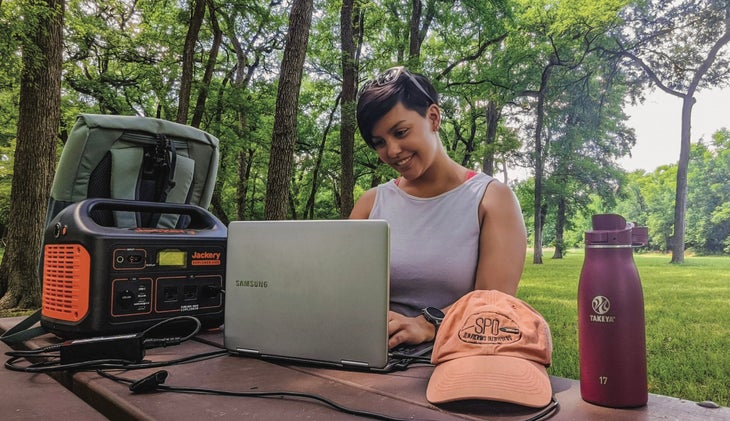
I’d been hiking through a forest, past waterfalls, and across creeks by myself for five hours in the North Chickamauga Creek Gorge State Natural Area near Chattanooga when my Garmin fenix 6S Pro Solar GPS watch died. I’d used it a lot the past few days—tracking my hikes and watching for thunderstorms that threatened to flood me off Lookout Mountain—and I hadn’t noticed that it needed to be recharged.
Not a minute later, my dad called and asked, “Are you still hiking?” At the same time, a text from my mom came through, conveying the same concern. The safety tracking feature had turned off, and my loved ones were in the dark about my whereabouts.
I often hike, bike, trail run, or camp by myself all across the country. And as a solo woman of color, when I do, you can bet I’m always connected to the internet. You can catch me in front of a campfire with my laptop on my knees or checking my phone while hiking in Palo Duro Canyon State Park. Passersbys have joked, “Stop working—you’re on vacation.” Others boast about how they left their phone in their car.
These jokes and subtle comments speak to an old-fashioned way of thinking. See, outdoor purists will tell you that unplugged outdoor experiences are “real” or “better,” but that’s a limited and privileged perspective. And I’m over it.
Whether I’m camping with family at a lake in Oklahoma or glamping by myself in a treehouse near Austin, I always have my laptop with me and my hotspot active. As a freelance writer, I must be connected: I’m not yet in a position in my career where I can leave my laptop at home, even for a few days. Sometimes I need to finish an article before kayaking, or answer an email from an editor who’s offering me an opportunity for a high-paying, quick-turnaround piece.
I’m not alone in this experience. With the pandemic, many jobs went remote, and that gave people an opportunity to work while on the move. Technology, like Wi-Fi hotspots and solar generators, allowed people to work and enjoy the outdoors more than they’d ever been able to do before. Isn’t that the dream?
Of course I don’t want to bring my laptop to a cabin in the woods, but that’s where I am in my career, and I shouldn’t be judged because I’m not financially able to leave my technology at home. Even if I get to a point where I don’t need to work while outdoors, the reality is, technology and internet access make the outdoors safer for me.
With my phone and smartwatch, I can keep track of harsh weather conditions, ensure I don’t get lost, notify authorities in case of a medical emergency, or share safety concerns about a trail, tour guide, or campsite with other people. As much as we’d like to think that the outdoors is safe for all, women, people of color, the queer community, and many other underrepresented groups still face harassment, threats, and assault in the outdoors. We can mitigate this danger with technology and help ourselves and our loved ones feel more confident when we’re in nature.
Safety and career needs aside, I can think of a million other ways that connectivity has improved my outdoor experience—not least, Googling “how to start a campfire” while glamping in West Texas, or calling a friend to pick me and my foldable kayak up from a boat launch because I was unable to paddle upstream to my car. (And yes, I like pulling my phone out and taking photos of myself in nature—sue me.)
Instead of judging people for using the internet, laptops, phones, and other technology in the outdoors, we should toss those purist notions aside and cheer them on. Who cares if they’re online? The fact that they’re outdoors is what matters most.


